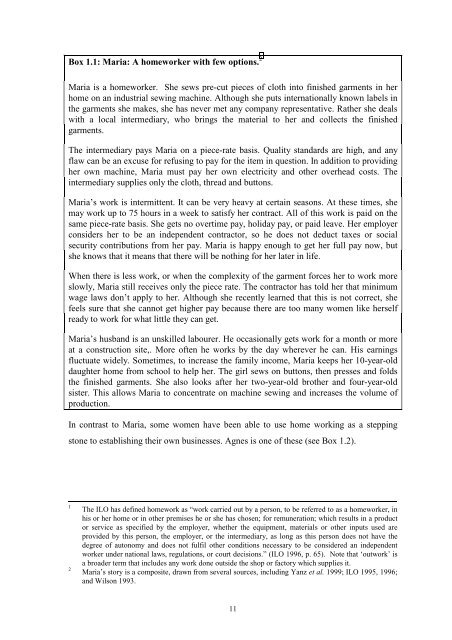McCormick+Schmitz Handbook for value chain research on - PACA
McCormick+Schmitz Handbook for value chain research on - PACA
McCormick+Schmitz Handbook for value chain research on - PACA
You also want an ePaper? Increase the reach of your titles
YUMPU automatically turns print PDFs into web optimized ePapers that Google loves.
Box 1.1: Maria: A homeworker with few opti<strong>on</strong>s. 2<br />
Maria is a homeworker. She sews pre-cut pieces of cloth into finished garments in her<br />
home <strong>on</strong> an industrial sewing machine. Although she puts internati<strong>on</strong>ally known labels in<br />
the garments she makes, she has never met any company representative. Rather she deals<br />
with a local intermediary, who brings the material to her and collects the finished<br />
garments.<br />
The intermediary pays Maria <strong>on</strong> a piece-rate basis. Quality standards are high, and any<br />
flaw can be an excuse <str<strong>on</strong>g>for</str<strong>on</strong>g> refusing to pay <str<strong>on</strong>g>for</str<strong>on</strong>g> the item in questi<strong>on</strong>. In additi<strong>on</strong> to providing<br />
her own machine, Maria must pay her own electricity and other overhead costs. The<br />
intermediary supplies <strong>on</strong>ly the cloth, thread and butt<strong>on</strong>s.<br />
Maria’s work is intermittent. It can be very heavy at certain seas<strong>on</strong>s. At these times, she<br />
may work up to 75 hours in a week to satisfy her c<strong>on</strong>tract. All of this work is paid <strong>on</strong> the<br />
same piece-rate basis. She gets no overtime pay, holiday pay, or paid leave. Her employer<br />
c<strong>on</strong>siders her to be an independent c<strong>on</strong>tractor, so he does not deduct taxes or social<br />
security c<strong>on</strong>tributi<strong>on</strong>s from her pay. Maria is happy enough to get her full pay now, but<br />
she knows that it means that there will be nothing <str<strong>on</strong>g>for</str<strong>on</strong>g> her later in life.<br />
When there is less work, or when the complexity of the garment <str<strong>on</strong>g>for</str<strong>on</strong>g>ces her to work more<br />
slowly, Maria still receives <strong>on</strong>ly the piece rate. The c<strong>on</strong>tractor has told her that minimum<br />
wage laws d<strong>on</strong>’t apply to her. Although she recently learned that this is not correct, she<br />
feels sure that she cannot get higher pay because there are too many women like herself<br />
ready to work <str<strong>on</strong>g>for</str<strong>on</strong>g> what little they can get.<br />
Maria’s husband is an unskilled labourer. He occasi<strong>on</strong>ally gets work <str<strong>on</strong>g>for</str<strong>on</strong>g> a m<strong>on</strong>th or more<br />
at a c<strong>on</strong>structi<strong>on</strong> site,. More often he works by the day wherever he can. His earnings<br />
fluctuate widely. Sometimes, to increase the family income, Maria keeps her 10-year-old<br />
daughter home from school to help her. The girl sews <strong>on</strong> butt<strong>on</strong>s, then presses and folds<br />
the finished garments. She also looks after her two-year-old brother and four-year-old<br />
sister. This allows Maria to c<strong>on</strong>centrate <strong>on</strong> machine sewing and increases the volume of<br />
producti<strong>on</strong>.<br />
In c<strong>on</strong>trast to Maria, some women have been able to use home working as a stepping<br />
st<strong>on</strong>e to establishing their own businesses. Agnes is <strong>on</strong>e of these (see Box 1.2).<br />
1<br />
2<br />
The ILO has defined homework as “work carried out by a pers<strong>on</strong>, to be referred to as a homeworker, in<br />
his or her home or in other premises he or she has chosen; <str<strong>on</strong>g>for</str<strong>on</strong>g> remunerati<strong>on</strong>; which results in a product<br />
or service as specified by the employer, whether the equipment, materials or other inputs used are<br />
provided by this pers<strong>on</strong>, the employer, or the intermediary, as l<strong>on</strong>g as this pers<strong>on</strong> does not have the<br />
degree of aut<strong>on</strong>omy and does not fulfil other c<strong>on</strong>diti<strong>on</strong>s necessary to be c<strong>on</strong>sidered an independent<br />
worker under nati<strong>on</strong>al laws, regulati<strong>on</strong>s, or court decisi<strong>on</strong>s.” (ILO 1996, p. 65). Note that ‘outwork’ is<br />
a broader term that includes any work d<strong>on</strong>e outside the shop or factory which supplies it.<br />
Maria’s story is a composite, drawn from several sources, including Yanz et al. 1999; ILO 1995, 1996;<br />
and Wils<strong>on</strong> 1993.<br />
11














